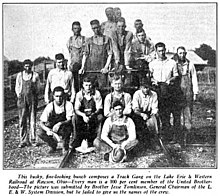

Gandy dancer is a slang term used for early railroad workers in the United States, more formally referred to as section hands, who laid and maintained railroad tracks in the years before the work was done by machines. The British equivalents of the term gandy dancer are navvy (from navigator), originally builders of canals, or inland navigations, for builders of railway lines, and platelayer for workers employed to inspect and maintain the track. In the Southwestern United States and Mexico, Mexican and Mexican-American track workers were colloquially traqueros.
In the United States, early section crews were often made up of recent immigrants and ethnic minorities who vied for steady work despite poor wages and working conditions, and hard physical labor. The Chinese, Mexican Americans, and Native Americans in the Western United States, the Irish in the Midwestern United States, African Americans in the Southern United States, and East Europeans and Italians in the Northeastern United States all worked as gandy dancers.
There are various theories about the derivation of the term, but most refer to the "dancing" movements of the workers using a specially manufactured five-foot (1.5 m) "lining" bar, which came to be called a "gandy", as a lever to keep the tracks in alignment.[1]
